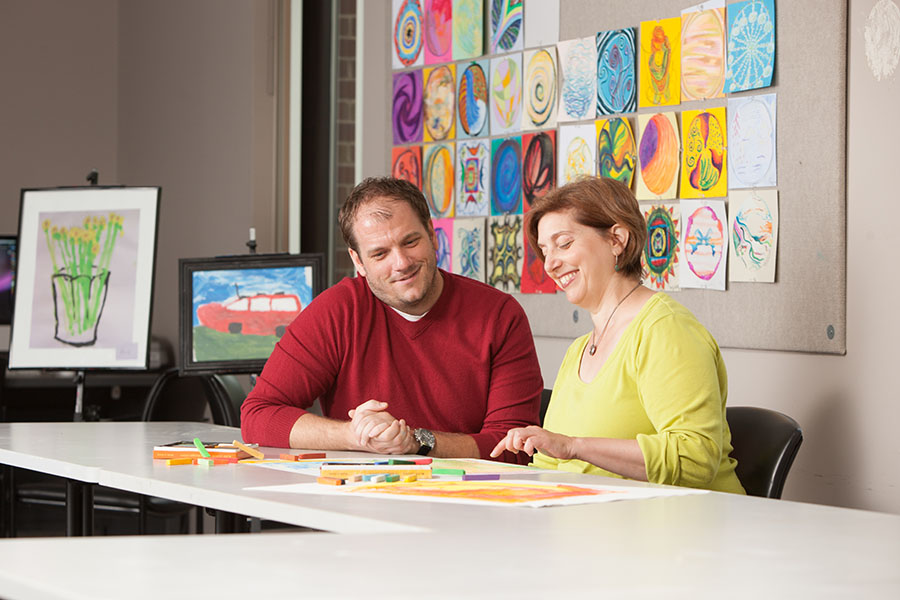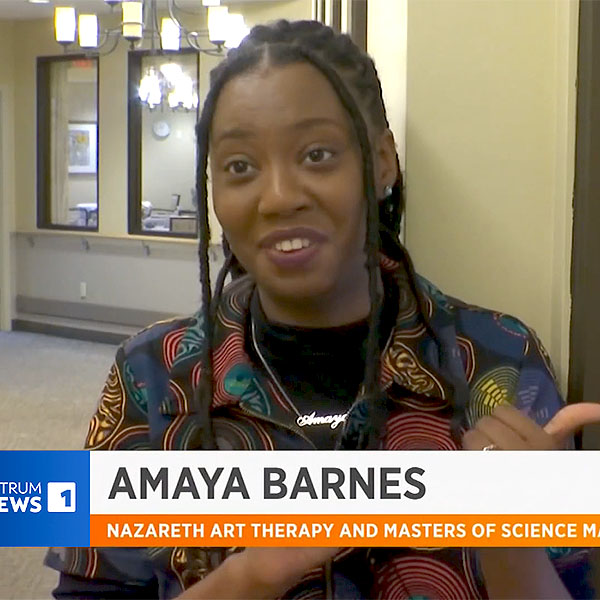Art Therapy
Master of Science in Creative Arts Therapy
When words are not enough, make art.
- Unique in the United States, the 60-credit art therapy degree program provides interdisciplinary training and clinical work.
- Collaborate interprofessionally at the on-site art therapy clinic gaining hands-on experience through consultation, observation, and co-treatment with future professionals in social work, occupational therapy, physical therapy, speech-language pathology, and music therapy — all while serving the local community.
- The program qualifies students for the New York state licensed creative arts therapy (LCAT) credential.

Highlights
Classes mostly daytime; some evening courses offered.
Study full- or part-time
Complete in as fast as 2 years full-time
Internships on and off campus
Program is Ideal For
- People who have an undergraduate degree in art or psychology and wish to use art therapeutically to serve others. Prerequisite coursework in studio art and psychology is required.
What to Expect
- Gain hands-on experience your first year interning on campus in the art therapy clinic in Nazareth's state-of-the-art York Wellness and Rehabilitation Institute (YWRI). In your second year, intern in a community setting with a variety of populations.
- You have the option to include an early-intervention interprofessional concentration (track): Rochester Scholars for Early Intervention helps you develop specialty knowledge and skills to be a strong advocate for young children and their families.
- Learn highly collaborative and interdisciplinary approaches.

Why Nazareth?
"The support from faculty and the experiential learning opportunities were strong. Supervision was readily available, and every student’s individual needs and interests were taken into account. My degree has enabled me to do what I love while providing a valuable service to my community. I love having the chance to support clients in their growth and healing process."
— Shane Updike ’23G works as a primary therapist at Rochester Regional Health’s St. Mary's location, and as an art therapist at Canalside Therapeutic Arts.
Value of Your Degree
- Graduates have been highly successful in passing the Art Therapy Credentials Board (ATCB) certification exam.
- Post graduation, art therapists find employment throughout the United States and abroad working in hospitals, clinics, social services, community agencies, wellness centers, educational institutions, businesses, and private practices.
- Clinical rotation exceeds the American Art Therapy Association's (AATA) educational requirement, so graduates are well prepared for a variety of settings.
- This department's accreditation by the National Association of Schools of Art and Design (NASAD) means our faculty, curriculum, and facilities meet or exceed national standards.
- Salaries vary by employer and location. Median salary estimate: $63,650 (2023), according to the U.S. Bureau of Labor Statistics, which includes art therapists in a broad therapists category.
Statistics
| Year | Program Retention | Job Placement |
|---|---|---|
| 2025 | 100% | TBD |
| 2024* | 86% | 100% |
| 2023 | 80% | 100% |
| 2022 | 82% | 88% |
| 2021 | 91% | 100% |
| 2020 | 87% | 58% |
| 2019 | 87% | 92% |
| 2018 | 89% | 100% |
| 2017 | 87% | 100% |
* Based on a 100% knowledge rate for 2024 graduates
Career Paths
- Art therapist
- Primary therapist
- Clinician
- Mental health therapist
- School-based therapist,
- Addictions therapist
- Outpatient therapist
Making Grad School Affordable
Grants, scholarships, veterans benefits, loans, and undergraduate loan forgiveness are options for paying for this grad degree.
Music and Art Therapy Co-Treatment
Music therapy intern Shannon Stott '25G and art therapy intern Melissa Gernon '99G, '24G, SSJ team up to provide their client a multi-sensory experience on the drums. The client put paint on her fingers, and as she played the drum to the beat, a picture was created.
Accreditation
The art therapy program at Nazareth University is accredited by the Commission on Accreditation of Allied Health Education Programs (www.caahep.org) upon the recommendation of The Accreditation Council for Art Therapy Education (ACATE). Commission on Accreditation of Allied Health Education Programs. 25400 US Highway 19 North, Suite 158. Clearwater, FL 33763, 727-210-2350, www.caahep.org.

Experiential Learning
Spectrum News featured Naz art therapy grad students Tina Starr '25G and Amaya Barnes '25G taking their therapeutic skills to work with older adults in the community.